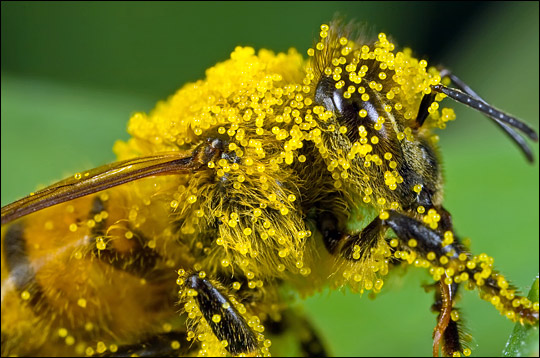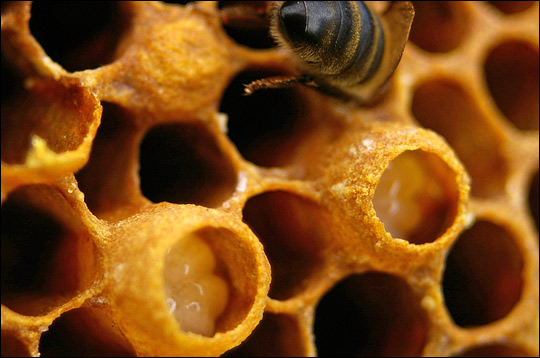

Will Plants and Pollinators Get Out of Sync? | |||
According to Esaias, the changes aren’t just dramatic, they’re also kind of scary. The fertility of most flowering plants, including nearly all fruits and vegetables, depends on animal-mediated pollination. As the pollinators move from flower to flower for nectar--a high-energy, sugary enticement—the plants dust them with pollen, which the animals transfer from flower to flower. |
|||
 | |||
“Flowering plants and pollinators co-evolved. Pollination is the key event for a plant and for the pollinators in the year. That’s where pollinators get their food, and that’s what determines whether the plant will set fruit. Some species of pollinators have co-evolved with one species of plant, and the two species time their cycles to coincide, for example, insects maturing from larva to adult precisely when nectar flows begin,” says Esaias. The concern is that in thousands upon thousands of cases, we don’t really know what environmental and genetic cues plants and pollinators use to manage this synchrony. According to ecologist David Inouye of the University of Maryland, some plant-pollinator pairs in a particular area likely do respond to the same environmental cues, and it’s reasonable to expect they will react similarly to climate change. But other pairs use different cues, the pollinator emerging in response to air temperature, for example, while the plant flowers in response to snow melt. Migratory pollinators, like hummingbirds, seem to be particularly at risk, since climate change will almost certainly affect different latitudes differently. There is no guarantee that the thousands of plant-pollinator interactions that sustain the productivity of our crops and natural ecosystems won’t be disrupted by climate change. |
Individual grains of pumpkin pollen hitch a ride on a honeybee. As bees move from flower to flower, they carry pollen with them, fertilizing nearby plants. This relationship between plants and pollinators may be affected by climate change. (Photograph ©2007 John Kimbler.) | ||
 | |||
As an example of how environmental cues for the timing of significant life cycle events might become uncoupled, Esaias points out that you don’t have to look any further than his bees. “What limits the growth of my honeybees in the spring are those coldest of the cold nights, because what is happening in their colony is that they are in a cluster, and they have to keep the queen and the larvae at 93 degrees. They do that by eating lots of honey, and tensing their muscles, and generating heat.” When it gets warm enough outside for them to maintain a temperature of 93 degrees, they start laying eggs around the edges of the cluster, and the cluster begins to expand. As long as the workers can keep the brood temperatures at 93 degrees, the eggs will grow into adult bees in about 3 weeks. But if a single cold, cold night in March intervenes, says Esaias, then eggs at the edges that the workers can’t keep warm will die. The cluster shrinks, and the colony must begin again. |
Honeybees aren’t the only pollinators affected by climate change. Hummingbirds and other migratory pollinators may be even more susceptible if their seasonal migrations become out of sync with the flowering and nectar availability in their breeding habitat. (Photograph ©2007 Maury Duchamp.) | ||
 | |||
“Trees, on the other hand, may not feel those cold temperatures in the same way because their roots are well insulated,” Esaias suggests. The sun-warmed ground is slower to chill than the air, so trees may not be feeling the cold snaps in the same way that the bee colony does. Thus, flowering may occur before the bee colony has built up enough workers to take advantage of it, which means the hive will struggle to stockpile enough honey to sustain them through the next winter. “I am not saying they are definitely different,” Esaias stresses, “I am just saying there are good reasons to think that their response to climate change would not be identical. The truth is we don’t know what the relationships are between weather and climate, pollinators, and plants for thousands of species.” Since crops alone can’t sustain the pollen and nectar requirements of honeybee colonies, the potential for honeybees and other pollinators to become out of sync with their most important natural food sources is something that concerns Esaias. A national network of scale-equipped honeybee hives, Esaias believes, would reveal when flowering occurs now and help us better predict how plants and pollinators in both natural and agricultural ecosystems will—or won’t—adapt to climate change in the future. Perhaps the best part of the whole idea, according to Esaias, is that 1-to-5-kilometer-radius area in which a hive’s worker bees forage is the same spatial scale that many ecological and climate models use to predict ecosystems’ responses to climate change. It also matches the spatial scale of satellite images of vegetation collected by NASA’s Terra and Aqua satellites. This similarity of scale means that all these ways of studying ecosystems could be integrated into a more sophisticated picture of how plant and animal communities will respond to climate change than any one method alone could provide. Esaias is particularly interested in comparing the hive data to satellite-based maps of vegetation “greenness,” a scale that remote-sensing scientists commonly use to map the health and density of Earth’s vegetation. Scientists have been making these types of maps for decades, and they have used them to document how warming temperatures in the Northern Hemisphere are causing vegetation to green up earlier in the spring than it did in the 1980s. Such maps are an excellent general indicator of seasonal changes in vegetation, says Esaias, but by themselves, they won’t tell you something as tangible as when plants are flowering. “But if we compare flowering times based on the bee hives to the satellite data, it’s possible we will see some correlated signal or pattern that we didn’t notice before,” he says. “If we can establish a relationship between the hive data in a particular ecosystem and satellite data, then we could use our global satellite data from Terra and Aqua to map flowering times for similar ecosystems. We could make predictions about what is happening to nectar flows and the species that depend on them in places where we don’t have scale hives.” That sort of ground-truth data from scale hives could also be used to evaluate ecosystem models. According to Hank Shugart, a scientist at the University of Virginia who specializes in forest ecosystem modeling, the timing of seasonal events like leaf emergence and flowering are usually related to the accumulated time an area spends above a plant’s minimum growth temperature, a biological benchmark known as “growing degree days.” “It turns out that these heat-sum type approaches are pretty good at predicting the timing of these seasonal events,” says Shugart. In general, a plant will put out leaves or flower after the number of growing degrees days that species requires has passed. “What that means,” he says, “is that the greening-up that the satellites can see is probably also related, for most plants, to their flowering time,” which satellites cannot see. Honeybee hive data would be “a marvelous idea” for verifying the connections, says Shugart. |
Broods of honeybee larvae depend on warm temperatures to survive. An early-spring cold snap can kill the developing workers at the outer edges of the cluster at the heart of the hive. This setback slows the hive’s preparations for the honey-production season. If plants are not affected in the same way, the bees may become out of sync with their primary food source. (Photograph ©2005 Max Westby.) | ||